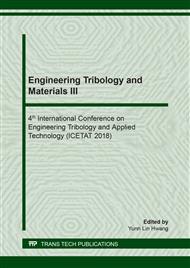[1]
Piotr Stpień. Regular Surface Texture Generated by Special Grinding Process[J]. Journal of Manufacturing Science & Engineering, 2009, 131(1):123-136.
Google Scholar
[2]
Khruschov M M. Principles of abrasive wear[J]. Wear, 1974, 28(1):69-88.
DOI: 10.1016/0043-1648(74)90102-1
Google Scholar
[3]
Rabinowicz E, Dunn L A, Russell P G. A study of abrasive wear under three-body conditions[J]. Wear, 1961, 4(5):345-355.
DOI: 10.1016/0043-1648(61)90002-3
Google Scholar
[4]
Moore M A. The relationship between the abrasive wear resistance, hardness and microstructure of ferritic materials[J]. Wear, 1974, 28(1):59-68.
DOI: 10.1016/0043-1648(74)90101-x
Google Scholar
[5]
Mutton P J, Watson J D. Some effects of microstructure on the abrasion resistance of metals ☆[J]. Wear, 1978, 48(2):385-398.
DOI: 10.1016/0043-1648(78)90234-x
Google Scholar
[6]
Ibatan T, Uddin M S, Chowdhury M A K. Recent development on surface texturing in enhancing tribological performance of bearing sliders[J]. Surface & Coatings Technology, 2015, 272:102-120.
DOI: 10.1016/j.surfcoat.2015.04.017
Google Scholar
[7]
Kang M, Yong M P, Kim B H, et al. Micro- and nanoscale surface texturing effects on surface friction[J]. Applied Surface Science, 2015, 345:344-348.
DOI: 10.1016/j.apsusc.2015.03.194
Google Scholar
[8]
Han K M, Cho J S, Yoo J. Monocrystalline-like silicon solar cells fabricated by wet and dry texturing processes for improving light-trapping effect[J]. Vacuum, 2015, 115:85-88.
DOI: 10.1016/j.vacuum.2015.02.020
Google Scholar
[9]
Park H, Kwon S, Lee J S, et al. Improvement on surface texturing of single crystalline silicon for solar cells by saw-damage etching using an acidic solution[J]. Solar Energy Materials & Solar Cells, 2009, 93(10):1773-1778.
DOI: 10.1016/j.solmat.2009.06.012
Google Scholar
[10]
Wang Z, Yang M. Laser-guided discharge texturing for cold mill roller[J]. Journal of Materials Processing Technology, 2011, 211(11):1678-1683.
DOI: 10.1016/j.jmatprotec.2011.05.008
Google Scholar
[11]
Parreira J G, Gallo C A, Costa H L. New advances on maskless electrochemical texturing (MECT) for tribological purposes[J]. Surface & Coatings Technology, 2012, 212(212):1-13.
DOI: 10.1016/j.surfcoat.2012.08.043
Google Scholar
[12]
Kim D J, La J H, Kim S M, et al. The tribological performance of laser surface treated CrZrSiN thin films[J]. Materials Research Bulletin, 2014, 58:39-43.
DOI: 10.1016/j.materresbull.2014.03.018
Google Scholar
[13]
Bico J, Thiele U, Quéré D. Wetting of textured surfaces[J]. Colloids & Surfaces A Physicochemical & Engineering Aspects, 2002, 206(1–3):41-46.
DOI: 10.1016/s0927-7757(02)00061-4
Google Scholar
[14]
Saeidi F, Meylan B, Hoffmann P, et al. Effect of surface texturing on cast iron reciprocating against steel under starved lubrication conditions: A parametric study[J]. Wear, 2016, 348-349:17-26.
DOI: 10.1016/j.wear.2015.10.020
Google Scholar
[15]
Ripoll M R, Simič R, Brenner J, et al. Friction and Lifetime of Laser Surface–Textured and MoS 2 -Coated Ti6Al4V Under Dry Reciprocating Sliding[J]. Tribology Letters, 2013, 51(2):261-271.
DOI: 10.1007/s11249-013-0170-6
Google Scholar
[16]
Ma Chenbo. Lubrication calculation model and antifriction characteristics of textured surface [D]. China University of Mining and Technology, 2010. [17] Mello J D B D, Jr J L G, Costa H L. Influence of surface texturing and hard chromium coating on the wear of steels used in cold rolling mill rolls[J]. Wear, 2013, 302(1–2):1295-1309.
DOI: 10.1016/j.wear.2013.02.006
Google Scholar
[17]
Costa H L, Hutchings I M. Some innovative surface texturing techniques for tribological purposes[J]. Proceedings of the Institution of Mechanical Engineers, Part J: Journal of Engineering Tribology, 2015, 229(4): 429-448.
DOI: 10.1177/1350650114539936
Google Scholar
[18]
Li K, Yao Z, Hu Y, et al. Friction and wear performance of laser peen textured surface under starved lubrication[J]. Tribology International, 2014, 77(77):97-105.
DOI: 10.1016/j.triboint.2014.04.017
Google Scholar


